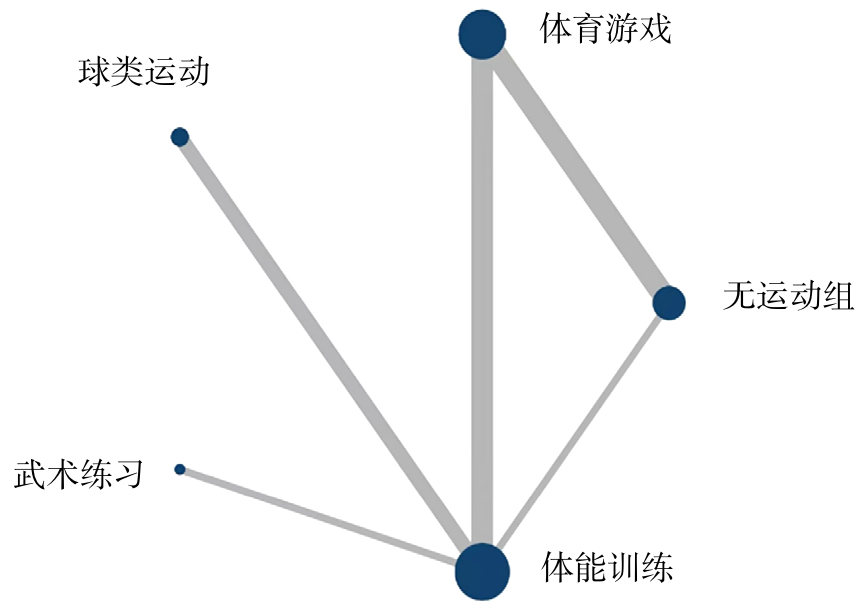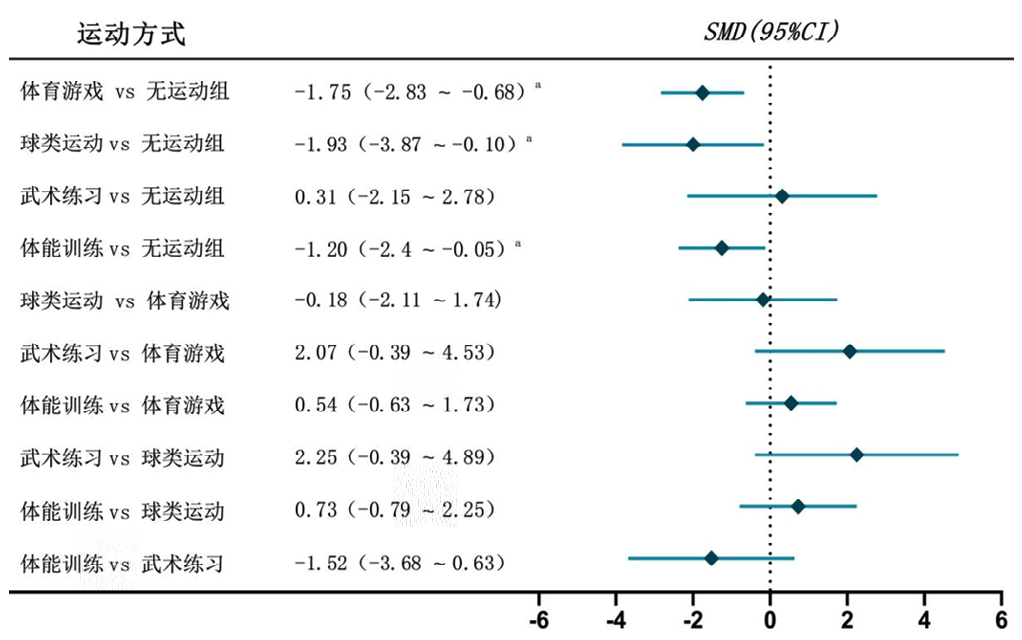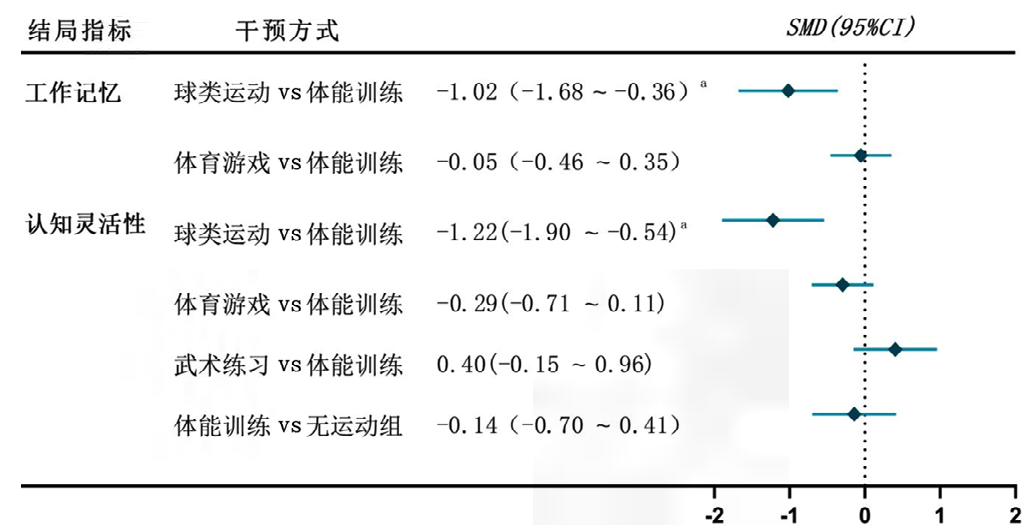中国全科医学 ›› 2025, Vol. 28 ›› Issue (27): 3422-3431.DOI: 10.12114/j.issn.1007-9572.2024.0626
所属专题: 儿科最新文章合辑
全家霖1, 朱琳1,2,3,*( ), 苏煜4, 陈泽恺1, 陈梓淇1, 张卓凡1
), 苏煜4, 陈泽恺1, 陈梓淇1, 张卓凡1
收稿日期:2025-01-03
修回日期:2025-03-24
出版日期:2025-09-20
发布日期:2025-07-22
通讯作者:
朱琳
作者贡献:
全家霖负责论文的选题、设计以及撰写,对整体工作负责;朱琳负责整体工作的指导、评估与文章审校;苏煜负责文章审校;陈泽恺负责文章审校与资料评估;陈梓淇和张卓凡负责资料收集、整理与评估等。
基金资助:
QUAN Jialin1, ZHU Lin1,2,3,*( ), SU Yu4, CHEN Zekai1, CHEN Ziqi1, ZHANG Zhuofan1
), SU Yu4, CHEN Zekai1, CHEN Ziqi1, ZHANG Zhuofan1
Received:2025-01-03
Revised:2025-03-24
Published:2025-09-20
Online:2025-07-22
Contact:
ZHU Lin
摘要: 背景 与健康体质量人群相比,超重或肥胖儿童青少年多存在执行功能缺陷,可能加剧超重或肥胖和诱发其他疾病。运动能促进执行功能已被证实,但不同运动方式效果的优劣仍需进一步探讨。 目的 探索改善超重或肥胖儿童青少年执行功能效果最佳的运动方式。 方法 检索中国知网、万方数据知识服务平台、Cochrane Library、PubMed、Embase和Web of Science数据库,汇总运动干预超重或肥胖儿童青少年执行功能的随机对照试验,检索时间为数据库建库至2024年10月。由2名研究人员独立进行文献筛选和资料提取,使用RevMan 5.4和Stata 18.0软件进行网状Meta分析,以标准化均数差(SMD)及其95%CI为效应指标,比较各运动方式间的差异以及计算累计概率排名曲线下面积(SUCRA)值并进行排序。采用Cochrane风险偏倚评估工具进行风险偏倚评估和Egger's检验进行发表偏倚分析。 结果 本研究共纳入10篇中英文文献,其中超重或肥胖儿童青少年675名,年龄8~15岁,结局指标为抑制控制、工作记忆和认知灵活性。共纳入4种运动方式组(体育游戏、球类运动、武术练习、体能训练)与无运动组。在改善抑制控制方面,与无运动组相比,体育游戏(SMD=-1.75,95%CI=-2.83~-0.68,P<0.05)、球类运动(SMD=-1.93,95%CI=-3.87~-0.10,P<0.05)、体能训练(SMD=-1.20,95%CI=-2.40~-0.05,P<0.05)均能提高超重或肥胖儿童青少年的抑制控制水平,其中球类运动SUCRA值最大(82.8),排序第一。在提高超重或肥胖儿童青少年的工作记忆方面,球类运动优于体能训练(SMD=-1.02,95%CI=-1.68~-0.36,P<0.05);在提高超重或肥胖儿童青少年的认知灵活性方面,球类运动优于体能训练(SMD=-1.22,95%CI=-1.90~-0.54,P<0.05)。 结论 与其他运动方式相比,球类运动在改善超重或肥胖儿童青少年的执行功能方面展现出了较优良的改善效果。在实践干预过程中应综合考虑球类运动与强度、周期、频率以及量的协同搭配。后续需进一步充实与超重或肥胖儿童青少年执行功能改善相关的证据,从而制订出更为精确、高效的运动处方。
中图分类号:
| 检索步骤 | 检索式 | 结果(篇) |
|---|---|---|
| #1 | Executive Function[MeSH Major Topic] | 11 972 |
| #2 | ((((((((((Executive Control[Title/Abstract])OR(Cognitive Function[Title/Abstract]))OR(cognitive performance[Title/Abstract]))OR(cognitive flexibility[Title/Abstract]))OR(Refresh function[Title/Abstract]))OR(working memory[Title/Abstract]))OR(Planning[Title/Abstract]))OR(cognitive function[Title/Abstract]))OR(Shifting[Title/Abstract]))OR(inhibitory control[Title/Abstract]))OR(Reasoning[Title/Abstract]) | 515 133 |
| #3 | #1 OR #2 | 520 986 |
| #4 | ((((((((((((child[Title/Abstract])OR(children[Title/Abstract]))OR(teenager[Title/Abstract]))OR(youth[Title/Abstract]))OR(adolescent[Title/Abstract]))OR(student[Title/Abstract]))OR(pupil[Title/Abstract]))OR(elementary school student[Title/Abstract]))OR(primary school student[Title/Abstract]))OR(junior high school student[Title/Abstract]))OR(middle school student[Title/Abstract]))OR(Juvenile[Title/Abstract]))OR(Youngster[Title/Abstract]) | 2 005 318 |
| #5 | (Obesity[MeSH Major Topic])OR(Overweight[MeSH Major Topic]) | 197 064 |
| #6 | ((Body mass index[Title/Abstract])OR(body fat[Title/Abstract]))OR(excess weight[Title/Abstract]) | 291 992 |
| #7 | #5 OR #6 | 431 286 |
| #8 | exercise[MeSH Major Topic] | 167 332 |
| #9 | (((((((((((((((aerobic training[Title/Abstract])OR(aerobic exercise[Title/Abstract]))OR(Physical Activity[Title/Abstract]))OR(Physical Exercise[Title/Abstract]))OR(Acute Exercise[Title/Abstract]))OR(Exercise,Isometric[Title/Abstract]))OR(endurance exercise[Title/Abstract]))OR(moderate intensity continuous training[Title/Abstract]))OR(Treadmill[Title/Abstract]))OR(resistance training[Title/Abstract]))OR(strength training[Title/Abstract]))OR(combined training[Title/Abstract]))OR(concurrent training[Title/Abstract]))OR(high intensity interval training[Title/Abstract]))OR(sprint interval training[Title/Abstract]))OR(physical activity[Title/Abstract]) | 251 880 |
| #10 | #8 OR #9 | 341 123 |
| #11 | #3 AND #4 AND #7 AND #10 | 263 |
表1 PubMed检索策略
Table 1 Search strategies in the PubMed
| 检索步骤 | 检索式 | 结果(篇) |
|---|---|---|
| #1 | Executive Function[MeSH Major Topic] | 11 972 |
| #2 | ((((((((((Executive Control[Title/Abstract])OR(Cognitive Function[Title/Abstract]))OR(cognitive performance[Title/Abstract]))OR(cognitive flexibility[Title/Abstract]))OR(Refresh function[Title/Abstract]))OR(working memory[Title/Abstract]))OR(Planning[Title/Abstract]))OR(cognitive function[Title/Abstract]))OR(Shifting[Title/Abstract]))OR(inhibitory control[Title/Abstract]))OR(Reasoning[Title/Abstract]) | 515 133 |
| #3 | #1 OR #2 | 520 986 |
| #4 | ((((((((((((child[Title/Abstract])OR(children[Title/Abstract]))OR(teenager[Title/Abstract]))OR(youth[Title/Abstract]))OR(adolescent[Title/Abstract]))OR(student[Title/Abstract]))OR(pupil[Title/Abstract]))OR(elementary school student[Title/Abstract]))OR(primary school student[Title/Abstract]))OR(junior high school student[Title/Abstract]))OR(middle school student[Title/Abstract]))OR(Juvenile[Title/Abstract]))OR(Youngster[Title/Abstract]) | 2 005 318 |
| #5 | (Obesity[MeSH Major Topic])OR(Overweight[MeSH Major Topic]) | 197 064 |
| #6 | ((Body mass index[Title/Abstract])OR(body fat[Title/Abstract]))OR(excess weight[Title/Abstract]) | 291 992 |
| #7 | #5 OR #6 | 431 286 |
| #8 | exercise[MeSH Major Topic] | 167 332 |
| #9 | (((((((((((((((aerobic training[Title/Abstract])OR(aerobic exercise[Title/Abstract]))OR(Physical Activity[Title/Abstract]))OR(Physical Exercise[Title/Abstract]))OR(Acute Exercise[Title/Abstract]))OR(Exercise,Isometric[Title/Abstract]))OR(endurance exercise[Title/Abstract]))OR(moderate intensity continuous training[Title/Abstract]))OR(Treadmill[Title/Abstract]))OR(resistance training[Title/Abstract]))OR(strength training[Title/Abstract]))OR(combined training[Title/Abstract]))OR(concurrent training[Title/Abstract]))OR(high intensity interval training[Title/Abstract]))OR(sprint interval training[Title/Abstract]))OR(physical activity[Title/Abstract]) | 251 880 |
| #10 | #8 OR #9 | 341 123 |
| #11 | #3 AND #4 AND #7 AND #10 | 263 |
| 第一作者 | 发表时间(年) | 样本量 | 年龄(岁)T/C | 超重/肥胖 | 运动方式(T/C) | 详细内容(T/C) | 强度(时间、频率、周期) | 结局指标 | |
|---|---|---|---|---|---|---|---|---|---|
| T(男/女) | C(男/女) | ||||||||
| KRAFFT[ | 2014 | 7/17 | 8/11 | 9.7±0.8/9.9±0.9 | 超重 | 体能训练/无运动组 | 进行教练指导的跳绳,追逐跑/无运动 | HR=160次/min(40 min/次、5 d/周、8个月) | ① |
| CROVA[ | 2014 | 20/17 | 15/18 | 9.6±0.5 | 超重 | 球类运动/体能训练 | 网球基本的运动技能和击打技巧练习/常规身体锻炼课程 | HR=150次/min(120 min/次、1 d/周、21周) | ①③ |
| CHEN[ | 2016 | 16/9 | 12/13 | 12.64±0.70/12.84±0.75 | 肥胖 | 体能训练/无运动组 | 快走,爬楼梯,跳绳或有氧舞蹈/无运动 | HR=(60%~70%)HRmax(40 min/次、4 d/周、3个月) | ② |
| LIU[ | 2018 | 20/15 | 20/15 | 13.94±0.94/14.17±0.71 | 肥胖 | 体能训练/无运动组 | 跳绳/无运动组 | HR=150~170次/min(75 min/次、2 d/周、12周) | ① |
| CHOU[ | 2020 | 27/17 | 25/15 | 12.30±0.66/12.08±0.69 | 超重 | 体育游戏/无运动组 | 团队游戏(改良足球、改良篮球、改良棒球)/无运动组 | HR>150次/min(40 min/次、3 d/周、8周) | ① |
| LOGAN[ | 2021 | 27/29 | 18/29 | 8.73±0.51/8.82±0.54 | 肥胖 | 体育游戏/体能训练 | 非竞争性的小型团体游戏提供MVPA/常规课后身体锻炼 | HR=(55%~80%)HRmax(120 min/次、5 d/周、36周) | ① |
| 朱慧兰[ | 2022 | 10/10 | 10/10 | 10.75±0.85/10.55±0.76 | 肥胖 | 球类运动/体能训练 | 篮球运球、投篮、上篮等基本技术练习/跑步、跳跃、投掷练习 | HR=135次/min(40 min/次、5 d/周、8周) | ①②③ |
| 曾丽冰[ | 2022 | 25 | 25 | 13.72±0.94/13.68±1.03 | 肥胖 | 武术练习/体能训练 | 武术基本技术动作练习/混合体育项目,涵盖健美操、TABATA、力量练习等 | HR=(85%~95%)HRmax(60 min/次、6 d/周、4周) | ①②③ |
| ORTEGA[ | 2022 | 47 | 43 | 9.99±1.13/10.10±1.13 | 肥胖 | 体育游戏/体能训练 | 以游戏为基础,分小组进行的多种身体游戏/常规的身体体能练习 | HR=80%HRmax(90 min/次、5 d/周、20周) | ①②③ |
| CHOU[ | 2023 | 14/11、13/12 | 13/12 | 11.37±0.58、11.00±0.64/11.32±0.54 | 超重 | 体育游戏/无运动组 | 团队游戏(改良足球、改良篮球、改良棒球)/无运动组 | HR>150次/min(20~40 min/次、5 d/周、10周) | ① |
表2 纳入文献的基本信息
Table 2 Basic characteristics of the included studies
| 第一作者 | 发表时间(年) | 样本量 | 年龄(岁)T/C | 超重/肥胖 | 运动方式(T/C) | 详细内容(T/C) | 强度(时间、频率、周期) | 结局指标 | |
|---|---|---|---|---|---|---|---|---|---|
| T(男/女) | C(男/女) | ||||||||
| KRAFFT[ | 2014 | 7/17 | 8/11 | 9.7±0.8/9.9±0.9 | 超重 | 体能训练/无运动组 | 进行教练指导的跳绳,追逐跑/无运动 | HR=160次/min(40 min/次、5 d/周、8个月) | ① |
| CROVA[ | 2014 | 20/17 | 15/18 | 9.6±0.5 | 超重 | 球类运动/体能训练 | 网球基本的运动技能和击打技巧练习/常规身体锻炼课程 | HR=150次/min(120 min/次、1 d/周、21周) | ①③ |
| CHEN[ | 2016 | 16/9 | 12/13 | 12.64±0.70/12.84±0.75 | 肥胖 | 体能训练/无运动组 | 快走,爬楼梯,跳绳或有氧舞蹈/无运动 | HR=(60%~70%)HRmax(40 min/次、4 d/周、3个月) | ② |
| LIU[ | 2018 | 20/15 | 20/15 | 13.94±0.94/14.17±0.71 | 肥胖 | 体能训练/无运动组 | 跳绳/无运动组 | HR=150~170次/min(75 min/次、2 d/周、12周) | ① |
| CHOU[ | 2020 | 27/17 | 25/15 | 12.30±0.66/12.08±0.69 | 超重 | 体育游戏/无运动组 | 团队游戏(改良足球、改良篮球、改良棒球)/无运动组 | HR>150次/min(40 min/次、3 d/周、8周) | ① |
| LOGAN[ | 2021 | 27/29 | 18/29 | 8.73±0.51/8.82±0.54 | 肥胖 | 体育游戏/体能训练 | 非竞争性的小型团体游戏提供MVPA/常规课后身体锻炼 | HR=(55%~80%)HRmax(120 min/次、5 d/周、36周) | ① |
| 朱慧兰[ | 2022 | 10/10 | 10/10 | 10.75±0.85/10.55±0.76 | 肥胖 | 球类运动/体能训练 | 篮球运球、投篮、上篮等基本技术练习/跑步、跳跃、投掷练习 | HR=135次/min(40 min/次、5 d/周、8周) | ①②③ |
| 曾丽冰[ | 2022 | 25 | 25 | 13.72±0.94/13.68±1.03 | 肥胖 | 武术练习/体能训练 | 武术基本技术动作练习/混合体育项目,涵盖健美操、TABATA、力量练习等 | HR=(85%~95%)HRmax(60 min/次、6 d/周、4周) | ①②③ |
| ORTEGA[ | 2022 | 47 | 43 | 9.99±1.13/10.10±1.13 | 肥胖 | 体育游戏/体能训练 | 以游戏为基础,分小组进行的多种身体游戏/常规的身体体能练习 | HR=80%HRmax(90 min/次、5 d/周、20周) | ①②③ |
| CHOU[ | 2023 | 14/11、13/12 | 13/12 | 11.37±0.58、11.00±0.64/11.32±0.54 | 超重 | 体育游戏/无运动组 | 团队游戏(改良足球、改良篮球、改良棒球)/无运动组 | HR>150次/min(20~40 min/次、5 d/周、10周) | ① |
| 运动方式 | 主要内容 |
|---|---|
| 体育游戏 | 为设计成游戏的身体活动,重点关注娱乐性,而非关注运动技能,以小组为基础,利用各种道具开展体育游戏,如将棒球、篮球、足球等进行游戏化,或是采用舞蹈、抓人、跳绳、身体游戏等形式开展游戏 |
| 球类运动 | 为进行球类基本运动技能练习,如篮球运球、投篮、上篮、传接球练习、网球的正反手等基本技能 |
| 武术练习 | 为开展武术基本动作,如弹腿、弓步和马步,拳法、腿法等 |
| 体能训练 | 为进行个人体能训练为主的活动,如跑步、跳绳、爬楼梯、跳远、跳高、投掷垒球实心球等基础体能练习 |
| 无运动组 | 不进行运动干预 |
表3 运动方式的主要内容
Table 3 Basic contents of exercise modes
| 运动方式 | 主要内容 |
|---|---|
| 体育游戏 | 为设计成游戏的身体活动,重点关注娱乐性,而非关注运动技能,以小组为基础,利用各种道具开展体育游戏,如将棒球、篮球、足球等进行游戏化,或是采用舞蹈、抓人、跳绳、身体游戏等形式开展游戏 |
| 球类运动 | 为进行球类基本运动技能练习,如篮球运球、投篮、上篮、传接球练习、网球的正反手等基本技能 |
| 武术练习 | 为开展武术基本动作,如弹腿、弓步和马步,拳法、腿法等 |
| 体能训练 | 为进行个人体能训练为主的活动,如跑步、跳绳、爬楼梯、跳远、跳高、投掷垒球实心球等基础体能练习 |
| 无运动组 | 不进行运动干预 |

图4 不同运动方式影响超重或肥胖儿童青少年童抑制控制的网状关系图注:点与点之间连线为2种运动方式直接比较,圆圈的大小表示纳入的样本量,线条宽度表示对比的频率。
Figure 4 Network relationship map of the impact of different exercise modes on inhibitory control in overweight and obese children and adolescents

图5 不同运动方式对超重或肥胖儿童青少年抑制控制影响的森林图注:a表示P<0.05。
Figure 5 Forest plot of the impact of different exercise modes on inhibitory control in overweight and obese children and adolescents

图6 不同运动方式对工作记忆和认知灵活性影响直接比较结果注:a表示P<0.05。
Figure 6 Results of pairwise comparisons of the impact of different exercise modes on working memory and cognitive flexibility
| [1] |
2015 Obesity Collaborators GBD,
|
| [2] |
|
| [3] |
|
| [4] |
|
| [5] |
|
| [6] |
|
| [7] |
|
| [8] |
史鹏,辛飞,张丁毅,等. 体育运动促进儿童青少年执行功能效益的理论探新[J]. 武汉体育学院学报,2023,57(11):75-83. DOI:10.15930/j.cnki.wtxb.2023.11.009.
|
| [9] |
|
| [10] |
|
| [11] |
|
| [12] |
|
| [13] |
|
| [14] |
|
| [15] |
|
| [16] |
|
| [17] |
|
| [18] |
|
| [19] |
|
| [20] |
|
| [21] |
|
| [22] |
|
| [23] |
|
| [24] |
刘爽洁,王明怡,王小春. 抑制控制训练对肥胖儿童抑制控制和体质量的作用[J]. 中国心理卫生杂志,2019,33(5):366-371.
|
| [25] |
|
| [26] |
|
| [27] |
|
| [28] |
|
| [29] |
|
| [30] |
赵瑞,陈乐琴,吴依妮,等. 有氧运动对超重肥胖儿童执行功能影响的Meta分析[J]. 中国全科医学,2024,27(30):3817-3824. DOI:10.12114/j.issn.1007-9572.2023.0810.
|
| [31] |
|
| [32] |
|
| [33] |
|
| [34] |
朱慧兰. 篮球运动对肥胖儿童执行功能的影响研究[D]. 上海:上海体育学院,2022.
|
| [35] |
|
| [36] |
尹龙,李芳,杨宗宇,等. 24 h活动行为与4~6岁儿童执行功能:基于具身认知的成分等时替代分析[J]. 武汉体育学院学报,2024,58(5):73-80.
|
| [37] |
宋以玲,范碧瑶,白啸天,等. 运动干预对注意缺陷多动障碍儿童青少年执行功能影响的Meta分析[J]. 中国儿童保健杂志,2023,31(9):1010-1016.
|
| [38] |
|
| [39] |
|
| [40] |
|
| [41] |
闫金,李世豪,丁明,等. 学龄期儿童体力活动对执行功能和学业成绩影响的Meta分析[J]. 中国学校卫生,2020,41(7):1055-1060. DOI:10.16835/j.cnki.1000-9817.2020.07.027.
|
| [42] |
陈爱国,陈丽萍,颜军. 8周足球运动改善留守儿童执行功能的实验研究[J]. 山东体育学院学报,2017,33(1):85-89.
|
| [43] |
|
| [44] |
|
| [45] |
|
| [46] |
|
| [47] |
|
| [48] |
|
| [49] |
曾丽冰. 四周集中武术训练对肥胖青少年认知功能及情绪影响的研究[D]. 上海:上海体育学院,2022.
|
| [50] |
|
| [51] |
|
| [52] |
|
| [53] |
|
| [54] |
朱慧兰,吴瑛,孟超. 运动干预对我国肥胖儿童执行功能的影响分析[C]//中国体育科学学会.第十二届全国体育科学大会,日照,2022.
|
| [55] |
|
| [56] |
殷恒婵,李鑫楠,陈爱国,等. 5种运动干预方案对小学生脑执行功能影响的试验研究[J]. 天津体育学院学报,2015,30(1):7-10. DOI:10.13297/j.cnki.issn1005-0000.2015.01.002.
|
| [57] | |
| [58] |
|
| [59] |
|
| [60] |
|
| [61] |
|
| [62] |
李华,张萍,甄志平. 不同运动方式对注意缺陷多动障碍儿童抑制控制影响的网状Meta分析[J]. 中国学校卫生,2024,45(4):497-502. DOI:10.16835/j.cnki.1000-9817.2024100.
|
| [63] |
|
| [64] |
|
| [65] |
|
| [66] |
|
| [67] |
|
| [68] |
|
| [69] |
|
| [70] |
|
| [71] |
陈爱国,朱丽娜,金柳,等. 运动干预对聋哑儿童执行控制及其脑网络功能连接的影响[J]. 体育与科学,2016,37(6):94-101. DOI:10.13598/j.issn1004-4590.2016.06.014.
|
| [72] |
|
| [73] |
|
| [74] |
李华,甄志平,张萍. 运动干预对儿童执行功能影响的网状meta分析[J]. 中国心理卫生杂志,2025,39(1):68-74.
|
| [75] |
|
| [76] |
傅培恩. 不同运动项目对中学生体育情境兴趣影响的比较研究[D]. 上海:上海师范大学,2011.
|
| [77] |
|
| [78] |
|
| [79] |
陈爱国,金柳,朱丽娜,等. 11周运动干预对聋哑儿童工作记忆的影响:来自行为和脑成像研究的证据[J]. 中国运动医学杂志,2016,35(12):1132-1139. DOI:10.16038/j.1000-6710.2016.12.009.
|
| [80] |
|
| [81] |
林飞,唐浩伦,汤强. 认知挑战性体育游戏对学龄儿童执行功能影响的meta分析[J]. 吉林体育学院学报,2023,39(6):77-89. DOI:10.13720/j.cnki.22-1286.2023.06.012.
|
| [82] |
王俊宇,杨永,郭学军,等. 运动结合认知训练对健康儿童执行功能影响的系统综述[J]. 中国循证儿科杂志,2023,18(5):393-398. DOI:10.3969/j.issn.1673-5501.2023.05.011.
|
| [83] |
|
| [84] |
任园春,宋以玲,谢永涛. 运动改善注意缺陷多动障碍儿童抑制功能的meta分析[J]. 中国心理卫生杂志,2022,36(3):217-223.
|
| [85] |
解超. 不同运动强度对儿童青少年工作记忆影响的Meta分析[J]. 中国学校卫生,2020,41(3):356-360. DOI:10.16835/j.cnki.1000-9817.2020.03.010.
|
| [86] |
陈爱国,冯磊,朱丽娜,等. 不同持续时间的中等强度篮球运动对儿童执行功能的影响[J]. 首都体育学院学报,2015,27(3):223-227. DOI:10.14036/j.cnki.cn11-4513.2015.03.007.
|
| [87] |
|
| [1] | 王婷婷, 唐勇, 张文轲, 李志刚. 高尿酸血症运动干预的研究进展[J]. 中国全科医学, 2025, 28(30): 3841-3846. |
| [2] | 白佳欣, 程玉, 周伊恒, 刘力滴, 杨荣, 姚易, 袁波, 张永刚, 雷弋, 曾锐, 贾禹, 廖晓阳. 《早发性高血压的评估与治疗:英国和爱尔兰高血压协会立场声明》对中国早发性高血压临床管理的建议[J]. 中国全科医学, 2025, 28(30): 3741-3746. |
| [3] | 吕娟, 李豫川, 蔡思雨, 王晨. 身高正常儿童内分泌科就医原因及非医疗干预需求分析:一项定性研究[J]. 中国全科医学, 2025, 28(30): 3766-3772. |
| [4] | 张鹏, 刘力滴, 张颖, 杨梓钰, 刘长明, 唐以俊, 廖晓阳, 贾禹. 2024意大利《成人超重、肥胖和代谢合并症行为治疗抵抗的管理指南》解读与启示[J]. 中国全科医学, 2025, 28(30): 3747-3752. |
| [5] | 卢冬磊, 杨风英, 冯展鹏, 曹立全, 谭思洁. 同期训练可改善伴有超重或肥胖2型糖尿病患者的健康效应:一项Meta分析[J]. 中国全科医学, 2025, 28(27): 3410-3421. |
| [6] | 赵玉晴, 王伟, 陈立沅, 油惠娟, 魏莹, 王清路, 杨风英. 肝脏巨噬细胞极化:运动防治非酒精性脂肪性肝病的新靶向[J]. 中国全科医学, 2025, 28(27): 3456-3465. |
| [7] | 邵晓颖, 邵洁, 朱焱, 邵金玲, 尚灵, 吴振莲, 赵钰, 张加才. 贵州省6~36月龄儿童铁缺乏现状及缺铁性贫血影响因素研究[J]. 中国全科医学, 2025, 28(27): 3368-3374. |
| [8] | 徐艳朋, 黄佩, 张平平, 罗艳, 施晓琪, 吴柳松, 陈艳, 何志旭. 急性T淋巴细胞白血病β-肾上腺素受体的表达情况及临床意义研究[J]. 中国全科医学, 2025, 28(27): 3391-3398. |
| [9] | 张宇诺, 李瑞斌, 王玮. 血清Nesfatin-1和Ghrelin水平与糖脂代谢及2型糖尿病的关系研究[J]. 中国全科医学, 2025, 28(26): 3264-3270. |
| [10] | 向心月, 张冰青, 欧阳煜钦, 汤文娟, 冯文焕. 短期内科门诊减重对肥胖患者动脉粥样硬化性心血管疾病风险的影响研究[J]. 中国全科医学, 2025, 28(26): 3229-3239. |
| [11] | 李苗秀, 朱博文, 孔令军, 房敏. 青少年脊柱侧弯保守治疗临床评估工具研究进展[J]. 中国全科医学, 2025, 28(24): 3079-3088. |
| [12] | 魏云鸿, 杨莉, 王玉路, 叶秋芳, 代安妮, 何燕. 肥胖相关性高血压患者不同运动阶段心肺功能的研究[J]. 中国全科医学, 2025, 28(24): 2972-2978. |
| [13] | 聂丹宁, 史曙生, 陶昱如. 本体感觉神经肌肉促进技术联合螺旋稳定肌肉链训练治疗青少年特发性脊柱侧弯的临床效果研究[J]. 中国全科医学, 2025, 28(24): 3032-3042. |
| [14] | 那飞扬, 杨译, 王雍, 王雁南. 2014—2023年兰州地区0~14岁儿童慢性咳嗽的病因研究[J]. 中国全科医学, 2025, 28(24): 3026-3031. |
| [15] | 蒋世华, 朱政, 任盈盈, 朱垚磊, 王越, 高希彬. 中国儿童青少年近视患病率及影响因素的Meta分析[J]. 中国全科医学, 2025, 28(24): 3043-3052. |
| 阅读次数 | ||||||
|
全文 |
|
|||||
|
摘要 |
|
|||||





